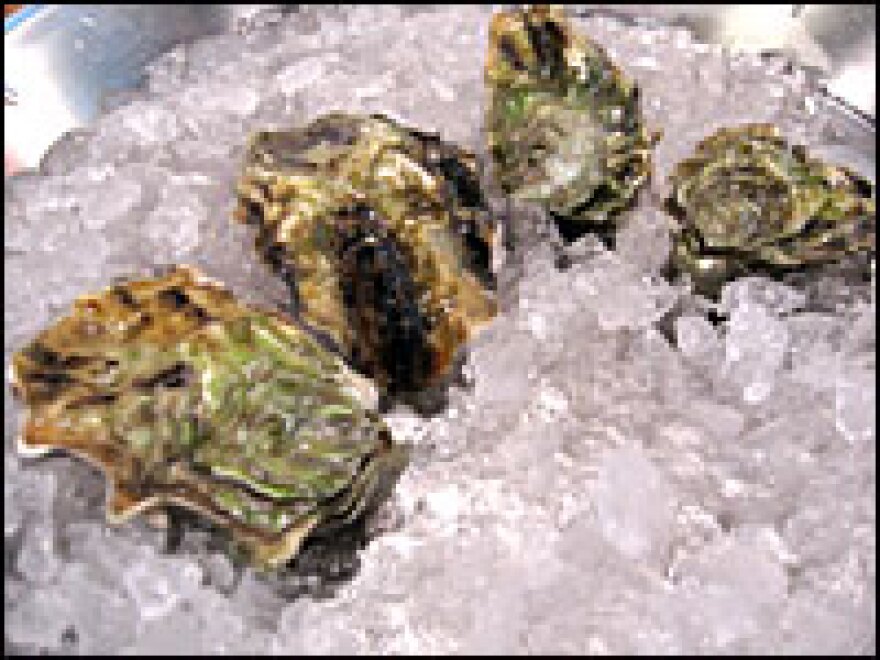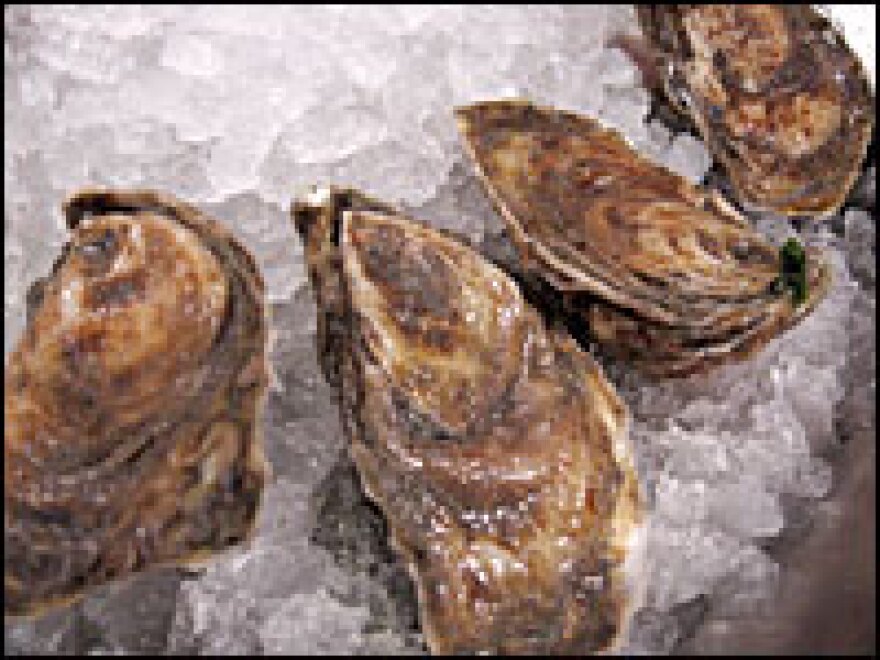


More than any other food, oysters have what author Rowan Jacobsen calls "somewhereness" — they taste like the place they come from.
"With oysters, there are no intermediaries. It's a very direct experience," says the author of A Geography of Oysters, a guide to oyster eating.
"That food is exactly the same as it was when it was pulled out of the ocean," he says. "It's come to you on a plate somewhere and nobody's done anything to manipulate that food. In fact, the food was alive until just moments before."
Birth of an Oyster Fan
Rowan Jacobsen ate his first oyster when he was 12 — at Stormy's bar on Florida's Atlantic coast. They were a dime apiece at happy hour. Now, chances are one oyster will set you back at least $2.
Jacobsen's enthusiasm for oysters, however, hasn't diminished.
Take, for example, how he describes a temperamental mollusk in his book: "It is shamelessly bold. When it hits your tongue it slaps you awake like the opening blast of a bugler's reveille."
Jacobsen is writing about a Belon oyster, also known as a European flat, which he calls the "Sean Penn" of oysters: memorable and intense, but not one you'd want to eat every day.
Taste Test
During a recent visit, Hank's Oyster Bar just outside of Washington, D.C., has five kinds of oysters on the menu. And the restaurant has flown in a half-dozen more kinds — including some rare ones — for a tasting session.
All of them were plucked from their beds just the day before.
These oysters — like most sold in the United States — are farmed. Wild oysters fell victim long ago to overfishing and water pollution.
Among the oysters for tasting are West Coast Kumamotos and Olde Salts from Virginia.
"I'm picturing the Atlantic on a cold, gray, November day. It's like a shipwreck oyster," Jacobsen says of the Olde Salts.
An oyster will filter up to 50 gallons of water a day, and will take on the flavors of that water: salty, mineral, mossy, smoky or metallic.
'I Like Them Naked'
Jacobsen is somewhat of a purist when it comes to eating oysters.
"I've got no argument with a little, nice mignonette [a vinegar-based dipping sauce]. [Culinary pioneer] James Beard referred to cocktail sauce as 'the red menace,' and you can't argue with James Beard. ... I like them naked," Jacobsen says.
He is equally opposed to the cocktail fork many restaurants offer for eating oysters.
"I feel like the cocktail fork is a way of attempting to put a veneer of civilization on what's basically a pretty primitive act," Jacobsen says. "So, why pretend?"
Sexy Oysters
Next up for tasting are Penn Cove oysters from Washington state. They are multiyear winners of the annual Most Beautiful Oyster Contest at Elliott's Oyster House at Pier 56 in Seattle.
Jacobsen calls them the sexiest oysters he's ever seen.
"They ... get bountiful and succulent, and they have this gleam to them as they sit in their shells," he says. "They just look incredibly healthy and vivacious."
Oyster as Aphrodisiac
Jacobsen describes eating raw oysters as "kissing the sea on the lips." And of course, oysters are thought to have aphrodisiacal qualities.
He says the anecdotal evidence to support that idea is strong. But he doesn't think it's for the reasons that people tend to think aphrodisiacs work.
Many people point to oysters' high zinc content — zinc is needed to generate testosterone. But as Jacobsen points out, the second-best source of zinc is liver — not widely known as a mood enhancer.
Instead, Jacobsen thinks the link has more to do with the culture of oyster eating, which is slightly risky behavior.
"If you look around a bar, you see other oyster eaters, you know you've got some interesting characters there.
"And you're feeling really good because you've got all this vitality that you've just taken from the sea and put into yourself. You're just feeling good about life and that can manifest in all sorts of ways," Jacobsen says.
And as for another piece of conventional wisdom about oysters, Jacobsen does recommend sticking to the "r" rule: avoiding oysters from warm waters from May through August — the months without an "r" — both for safety and for taste.
Copyright 2023 NPR. To see more, visit https://www.npr.org.





